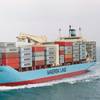Capesize rates firmed again worldwide, but brokers said charterers were increasingly conducting business under the counter. Panamax rates were also firmer east of Suez with both Chinese and Japanese charterers active in the Indian Ocean and the Pacific, while Atlantic Handysize conditions remained in the doldrums, they added.
On Feb. 23, the Baltic Dry Index (BDI) rose 10 points to 1,491, the Baltic Panamax Index gained one point to 1,419, The Baltic Capesize Index jumped up 27 points to 2,055 and the Baltic Handy Index firmed three points to 1,008.
There was confusion in the grain market concerning the alleged involvement of EMC in a fixture of 54,000 tons heavy grain U.S. Gulf/Japan for early March which was said to have been concluded at somewhere between the weaker levels of $20.50 and $21.
Confirmation was not available but some credibility was lent to these reports by news that modem Panamaxes in the U.S. Gulf first half March were said to be willing to accept lower timecharter rates U.S. Gulf/Far East in the region of $10,000 daily plus a $200,000 ballast bonus.
Some brokers believed that there were seven Panamax grain cargoes remaining to be shipped U.S. Gulf/China in March.
However, the most common view of the situation for Atlantic Panamaxes was that the market was not moving in the owners favor, and that there seemed little likelihood of any change until the South American market kicked in.
In assessing the continued strength of the Atlantic Capesize market, brokers commented on the significant delays in loading ports in Brazil and Colombia and discharging reports in Europe. It was also said that charterers were increasingly conducting off market business to disguise their activities. - (Reuters)
Featured videos

Send in the Drones (to deep, dark, confined maritime spaces)

Taking the First Step Toward Autonomy
Subscribe for
Maritime Reporter E-News
Maritime Reporter E-News is the maritime industry's largest circulation and most authoritative ENews Service, delivered to your Email five times per week











